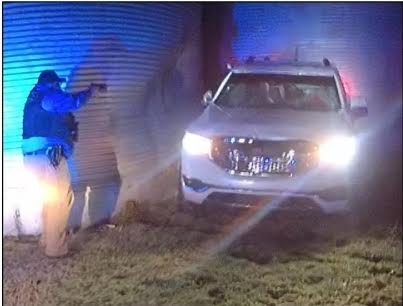Book review: ‘Prohibition: A Concise History’
Published 12:00 am Sunday, May 6, 2018

- BOOK REVIEW
“Prohibition: A Concise History” by W.J. Rorabaugh, New York: Oxford University Press, 2018. 144 pages, $18.95 (hardbound).
Alcohol. Well, now that I have your attention, I find it fascinates me and it appears that I’m not the only one. Historian and author W.J. Rorabaugh seems to find so as well, and why not? Alcohol has such a long history, and not just in terms of our own culture.
Trending
Much like the question of the chicken or the egg, there is now a debate as to which man made first: beer or bread. I don’t know the answer to that, but I am 99 percent sure that whichever came first, the other was a very close second. Even some primates have been known to ferment fruit in water and drink it. In a New Zealand avian version of, “Hey, hold my beer and watch this,” a rock pigeon eats fallen spoiled fruit that has fermented and then flies into the surrounding rock cliffs. Alcohol, simply put, is a part of our world.
Then came Prohibition, when 1920 was the last call for alcohol in the United States. For 13 years the 18th Amendment banned the production, transportation and sale of alcoholic beverages. Rorabaugh’s new book, “Prohibition: A Concise History,” is just that, a short but detailed look at America’s love/hate relationship with the demon drink.
Ben Franklin is credited with saying: “In wine there is wisdom, in beer there is freedom and in water there is bacteria.” This sums up the need for alcohol in the early days of our country. At that time in history, alcohol was safer than drinking water, but by the end of the American Revolution whiskey would be cheaper than coffee or milk. By 1820, the average American male drank nearly half a pint of whiskey a day. So how could a country with a taste for drink like that ban it altogether 100 years later? Rorabaugh answers that very question by looking not just at the political life of prohibition, but at all the events that would lead to a 180-degree turn in the American culture.
Even before the 1800s, alcohol was common in the Colonial life. Most housewives brewed their own low-alcohol beer, which was given to all family members, even children. The beer had enough alcohol to kill most of the bacteria that was found in the water, but it did not have much of a shelf life and would spoil quickly. Rum, on the other hand, was a popular hard drink with a long shelf life – that is, if it had stayed on the shelf. Taverns and public drinking houses played a large role in our country’s history as well. It was while sitting around places such as these that much of the revolutionary spirit began to form. John Hancock and his “Indians” planned the Boston Tea Party in a public house and Thomas Jefferson worked on the Declaration of Independence in the back room of a Philadelphia tavern. Drinking united and defined us as a country. With the British blockade, access to rum and the molasses it was made from was cut, forcing Americans to distill corn and rye, which were very available and thus very cheap to use. Better distilling technology began with the large number of Irish and Scottish immigrants during the 1760s. By the end of the war of independence, whiskey would be nearly the national beverage.
Consumption of whiskey after the Revolution rose, and so did the problems associated with alcoholism. Some began to warn that a drunken society was one ripe for poverty, crime and the destruction of the family. Drunkenness led to unemployment and the abandonment of children. It was also associated with gambling and prostitution, which many warned would lead to personal financial ruin and sexually-transmitted diseases.
The tide was beginning to turn. The religious revival of the early 19th century first urged Americans to switch to wine or beer. However, the cost and availability of both was a problem for most consumers. So the Protestant preachers started to call for total abstinence. Water was now much safer to drink thanks to public water systems in the larger cities and coffee, tea and cocoa imports increased, which drove their cost down, thus giving people safe alternatives to liquor. Teetotalers with the help of the mayor persuaded the legislature of Portland, Maine, to enact the first statewide ban on alcohol. This would become known as the Maine law. By 1855, 11 states would pass similar laws. However, a national ban was impossible at this time. For the growing number of German and Irish immigrants, drinking was still a part of their culture and not something they saw the need to give up.
Trending
By 1917, there were 23 dry states and it was just a matter of time before the country would take that final step. The Anti-Saloon League had used a slow, methodical approach to isolate liquor in those states little by little, using the local option that put the vote to the citizens of the towns and cities. World War I also had an effect on the way Americans felt about alcohol. Everyone, it seemed, opposed public drunkenness and most were willing to concede that alcohol abuse could lead to crime and violence, but many of these same people did not see any harm in a beer or glass of wine. Beer had gained its popularity because of the Irish and Germans. The big beer brewers were all of German descent and, although the United States Brewers’ Association was an American trade group, they kept their meeting minutes in German. As tensions in Europe rose, Americans began to question where the loyalty of the German-Americans would fall. Drinking beer was played by the drys as un-American. The food shortage in Europe saw restrictions placed on the amount of grain available for brewing. If ever the time was right to pass Prohibition it was now and on Dec. 18, 1917, the 18th Amendment was passed.
The last day alcohol could legally be made or sold in the United States was Jan. 16, 1920. People had until the stroke of midnight, and in many cities across the country saloons, restaurants and hotel bars held celebrations toasting in Prohibition with alcohol. Midnight came and Prohibition failed as partiers called for the next round. The fall of Prohibition is well known; corruption, mobsters, bootleggers and the Depression were all nails in its coffin. Imposing religious views and morality on everyone in the name of safeguarding others never works. If you want to sell a lot of anything, tell people they can’t have it anymore.
The law allowed for liquor stored and brewed before January 1920 to be used, and the Yale Club of New York stored enough alcohol to last until the month Prohibition was repealed. J.P. Morgan put thousands of cases of champagne aside. A double standard existed with the rich toasting the Prohibition of the working class with pre-Prohibition liquor. Stills popped up across the country, Canadian liquor crossed the border, as did rum on the east coast and American tourists poured into Tijuana and other border towns in the west. The price for alcohol went up, the quality went down, the country lost millions of dollars in taxes, and violence was on the rise. Al Capone, whose rise to power was made possible mostly by Prohibition, was to prove to be one of the reasons people would turn against Prohibition. After the St. Valentine’s Day Massacre, people had had enough.
“Prohibition: A Concise History” is just that, a short but to-the-point history of a confusing time in our history. It’s a fast roller-coaster ride of a read. What it lacks in length it makes up for in detail, just like a good stiff drink. Rorabaugh’s work proves that it’s the quality that counts more than the quantity.
– Reviewed by Lyrae Borders of Glasgow.






